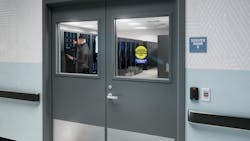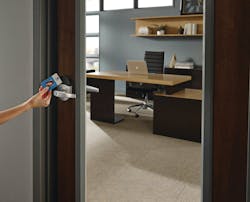Start Your Next Job with Multi-Tech Readers
Key Highlights:
· Multi-technology readers simplify access control by supporting a wide range of legacy and modern credentials, enabling seamless, phased upgrades without ripping and replacing hardware.
· Locksmiths can streamline installations, reduce inventory complexity, and support customer migrations by using unified, cloud-ready systems with field-upgradable firmware.
· With centralized management, consistent access policies, and support for secure protocols like OSDP, multi-technology readers future-proof security infrastructures while enhancing efficiency and scalability.
In today’s fast-evolving security landscape, locksmiths and integrators face an increasingly complex challenge: managing access control systems that span multiple buildings, sites, and legacy infrastructures — each with its own credential formats, communication protocols, and management platforms. The traditional “one building, one credential type” model may no longer fit the bill.
Enter multi-technology readers and electronic locks — the unsung heroes bridging these divides. Think of them as the Swiss Army knives of access control! By consolidating diverse credential technologies into a single hardware device and pairing it with unified, cloud-ready management, organizations gain seamless, site-wide (and even enterprise-wide) access control. Here’s how this game-changing approach works — and why it matters to locksmiths and security professionals.
· One Reader, Many Credentials
Multi-technology readers are designed to speak nearly every credential “language.” Factory-programmed or field-upgradeable, these readers can accept everything from legacy 125 kHz proximity cards to modern MIFARE, DESFire, ISO 15693 smart cards, and Bluetooth Low Energy (BLE) / Near Field Communication (NFC) mobile credentials. This capability means that on Day 1, they can read your existing cards and fobs — even if some of those legacy credentials have less modern security features — allowing organizations to plan a smooth transition toward smarter, more secure credentials.
What’s more, many multi-technology readers support firmware upgrades that add compatibility for new credential formats over time, such as mobile wallet credentials. This means organizations can update their readers’ software remotely without having to replace hardware, ensuring the system stays current with emerging technologies. For locksmiths, this translates to a significant reduction in inventory complexity, simplified retrofits, and the ability to support customer migrations from legacy to mobile credentials seamlessly.
· Phased Migration Strategies: Practical and Flexible
Cost and operational disruption often stall access control upgrades. Instead, installing multi-technology readers enables phased migration strategies that may ease this burden. One common approach involves replacing legacy readers with multi-technology readers while keeping the existing wiring intact. This setup allows users to continue using their legacy credentials alongside new credential technologies simultaneously during the transition period. By supporting both credential types in parallel, this method minimizes inconvenience and confusion for end users. Overall, it can significantly reduce downtime and spread upgrade costs over time — creating a win-win scenario for both customers and locksmiths.
One Lock Hardware, One Playbook
Different departments? No problem. Electronic locks compatible with multi-technology readers can be deployed across departments with varying security needs while still being managed identically. Even battery-powered offline locks with built-in multi-technology readers can join the credential ecosystem by logging access events locally and syncing them later with the central system. Centralized credential policies offer consistent access groups, time schedules, and event logging across all sites. This unified approach means that when an employee leaves, revoking their credential centrally immediately denies access everywhere, streamlining offboarding and enhancing security.
· Consistent Reporting and Auditing – No More Paper Chase
Managing audit logs across multiple access control systems can be a major headache. Multi-technology readers generate all door events, alarms, and tamper reports, which are then consolidated into a single, unified digital audit log by the access control system. This setup eliminates the tedious and error-prone process of manually collating logs from different systems. Additionally, alerts for events like forced-door openings or doors held open too long can be sent directly to security consoles, helping to improve situational awareness and enable faster response times.
· Future-Proofing and Scalability
As emerging technologies continue to expand, multi-technology readers can often be updated with new firmware modules to keep the entire access-control system in sync. This future-proofing method can help mitigate costly hardware replacements. Additionally, rolling out new readers to buildings or departments requires minimal retraining because the hardware, communication protocols, and software remain consistent. This scalability is a major advantage for companies with short or long-term growth or technology adoption.
· Common Communication Protocols: Wiegand and OSDP
Modern multi-technology readers may support wiring for the classic Wiegand interface and should support the more secure, bi-directional OSDP (Open Supervised Device Protocol) with Secure Channel encryption. OSDP provides encrypted communication that helps resist hacking and offers tamper detection and remote configuration capabilities. It also simplifies management of readers across multiple locations via IP gateways or controllers. By standardizing with OSDP or similar IP-based protocols found in reader controllers, locksmiths can reduce installation complexity and future-proof their customers’ systems.
· Centralized, Cloud-Ready Multi-Technology Reader
Today’s multi-technology readers often come as self-contained units integrating both the reader and access control panel board, managed through cloud-based software. This approach streamlines hardware installations by leveraging the skills locksmiths already possess. These modern devices can read most forms of credentials, including mobile wallet credentials, and centralize management tasks such as user rights assignment, firmware updates, and audit logging. The result is simplified administration and significantly lower risk of costly errors.
Why Locksmiths Should Embrace Multi-Technology Readers
Multi-technology readers offer several key benefits. They simplify inventory and installation by covering multiple credential types with a single device, reducing the complexity of stocking and configuring different reader models. Training is streamlined, since installers and administrators work with a unified interface and wiring scheme—typically supporting both Wiegand and OSDP protocols. Incremental upgrade paths allow phased migrations, helping to avoid costly and disruptive wholesale rip-and-replace projects. Finally, customers benefit from fewer help-desk calls and accelerated onboarding, which enhances satisfaction and builds trust in the locksmith’s expertise.
Getting Started: Your Playbook:
1. Conduct a thorough audit of every credential type in use, wiring topology, and panel capability. Understanding the full scope of your legacy system is critical to identifying gaps, pain points, and opportunities for improvement. Pro Tip: When installing multi-technology readers, always perform a thorough site survey. Check wall thickness, metal backboxes, and environmental ratings to ensure optimal performance and compliance with standards.
2. Choose multi-technology readers that support key protocols like OSDP with Secure Channel encryption, plus BLE/NFC mobile credentials and multiple card formats. Make sure the firmware is field-upgradable to keep your system flexible and future-ready.
3. Develop a phased upgrade plan for control panels — whether that means connecting legacy systems to new platforms or gradually replacing older panels to fit your client's budget and growth plans. This step helps avoid costly rip-and-replace scenarios and spreads investment over time.
4. Roll out migrations in waves by building, floor, or security zone. This phased approach manages complexity, minimizes disruption, and helps users adapt smoothly to new credentials and hardware.
5. Consolidate credentials under a unified access policy. This lets you retire vulnerable legacy cards and replace them with stronger, high-frequency options like MIFARE DESFire EV3 or mobile wallet NFC or BLE credentials — boosting security across the board.
6. Train your staff and end users on new credential issuance, management, and revocation processes. Clear, consistent training reduces confusion and helps ensure a smooth transition for everyone involved.
7. Establish ongoing governance with regular firmware updates and periodic audit-log reviews. Keeping your system patched and monitored is essential to maintaining security and operational integrity over time.
Real-World Impact
Locksmiths and integrators that adopt multi-technology readers may see substantial reductions in help-desk tickets related to credential issues, thanks to the seamless support of multiple credential types. Service callbacks can be reduced and become more streamlined with centralized management, and the life of legacy infrastructure is extended, reducing capital expenditures. Transitions to mobile and biometric credentials become smooth and less disruptive, enabling companies to keep pace with evolving security demands.
The Future of Access Control Is Here
Multi-technology readers and electronic locks are more than just hardware — they are the bridge to a unified, scalable, and future-ready access-control ecosystem. For locksmiths, mastering these technologies means delivering smarter, more flexible security solutions that grow with your customers’ needs without breaking budgets or causing downtime.
By embracing multi-technology readers, locksmiths can lead the charge toward simplified, secure, and scalable access control — a win for security teams, end users, and integrators alike.
KeShia Thomas is a brand and solutions marketing manager at Allegion, where she focuses on brand elevation, storytelling and strategic product marketing for access control.
About the Author
KeShia Thomas
KeShia Thomas is a brand and solutions marketing manager at Allegion.


